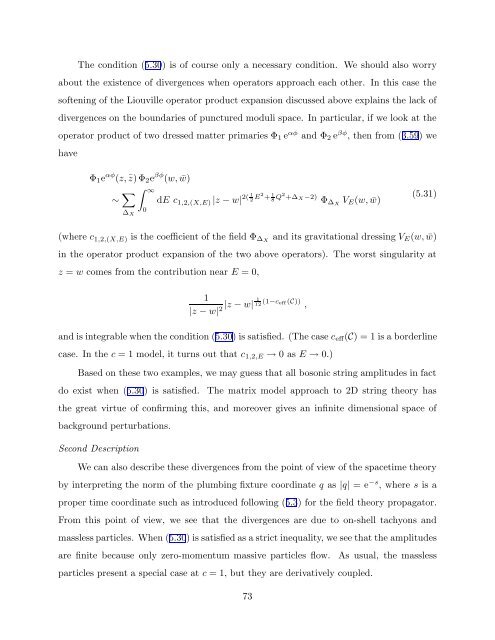arXiv:hep-th/9304011 v1 Apr 5 1993
arXiv:hep-th/9304011 v1 Apr 5 1993
arXiv:hep-th/9304011 v1 Apr 5 1993
You also want an ePaper? Increase the reach of your titles
YUMPU automatically turns print PDFs into web optimized ePapers that Google loves.
The condition (5.30) is of course only a necessary condition. We should also worry<br />
about <strong>th</strong>e existence of divergences when operators approach each o<strong>th</strong>er. In <strong>th</strong>is case <strong>th</strong>e<br />
softening of <strong>th</strong>e Liouville operator product expansion discussed above explains <strong>th</strong>e lack of<br />
divergences on <strong>th</strong>e boundaries of punctured moduli space. In particular, if we look at <strong>th</strong>e<br />
operator product of two dressed matter primaries Φ 1 e αφ and Φ 2 e βφ , <strong>th</strong>en from (3.59) we<br />
have<br />
Φ 1 e αφ (z, ¯z) Φ 2 e βφ (w, ¯w)<br />
∼ ∑ ∫ ∞<br />
dE c 1,2,(X,E) |z − w| 2( 1 2 E2 + 1 8 Q2 +∆ X −2) Φ ∆X V E (w, ¯w)<br />
∆ X<br />
0<br />
(5.31)<br />
(where c 1,2,(X,E) is <strong>th</strong>e coefficient of <strong>th</strong>e field Φ ∆X<br />
and its gravitational dressing V E (w, ¯w)<br />
in <strong>th</strong>e operator product expansion of <strong>th</strong>e two above operators). The worst singularity at<br />
z = w comes from <strong>th</strong>e contribution near E = 0,<br />
1<br />
|z − w| 2 |z − w| 1 12 (1−c eff (C)) ,<br />
and is integrable when <strong>th</strong>e condition (5.30) is satisfied. (The case c eff (C) = 1 is a borderline<br />
case. In <strong>th</strong>e c = 1 model, it turns out <strong>th</strong>at c 1,2,E → 0 as E → 0.)<br />
Based on <strong>th</strong>ese two examples, we may guess <strong>th</strong>at all bosonic string amplitudes in fact<br />
do exist when (5.30) is satisfied.<br />
The matrix model approach to 2D string <strong>th</strong>eory has<br />
<strong>th</strong>e great virtue of confirming <strong>th</strong>is, and moreover gives an infinite dimensional space of<br />
background perturbations.<br />
Second Description<br />
We can also describe <strong>th</strong>ese divergences from <strong>th</strong>e point of view of <strong>th</strong>e spacetime <strong>th</strong>eory<br />
by interpreting <strong>th</strong>e norm of <strong>th</strong>e plumbing fixture coordinate q as |q| = e −s , where s is a<br />
proper time coordinate such as introduced following (5.3) for <strong>th</strong>e field <strong>th</strong>eory propagator.<br />
From <strong>th</strong>is point of view, we see <strong>th</strong>at <strong>th</strong>e divergences are due to on-shell tachyons and<br />
massless particles. When (5.30) is satisfied as a strict inequality, we see <strong>th</strong>at <strong>th</strong>e amplitudes<br />
are finite because only zero-momentum massive particles flow.<br />
particles present a special case at c = 1, but <strong>th</strong>ey are derivatively coupled.<br />
73<br />
As usual, <strong>th</strong>e massless
















